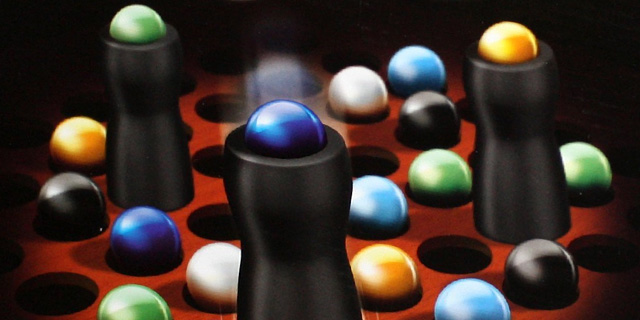
The majority of the games that I cover here — indeed, nearly all of them — are intended for the dedicated board gamer. There are usually a lot of rules, varying paths to victory, and plenty of strategic options; everything else is “just a filler” or perhaps “a party game”. They come from publishing companies unfamiliar to anyone not already invested in the hobby, and tend to only be found at specialized retailers. But sometimes a game from a more “mainstream,” traditionally toy-making company catches our attention and provides some throwback enjoyment. While often these are just spin-offs of older, established brands (such as Sorry! Sliders, Yahtzee Free-For-All or any number of variants on Risk), sometimes a genuinely unique title will emerge. Stomple, from Spin Master, is one such new arrival.
Stomple takes place on an elevated 7-by-7 grid of holes, supported by a foam-core board of slightly smaller — but expandable — holes. Seven different colors of marbles (seven each) are randomly distributed to this grid and then each player (from two to six) draws a “stomper” from the bag; a “stomper” is a large wooden pawn with one of six different marble colors on top of it, indicating which marbles are yours. The seventh color, the tiger-eyes, are bonus marbles that do not belong to anyone. The object of the game is to prevent your opponent(s) from being able to make a move.
On your first turn, you can move your stomper to any marble in the outer ring; doing so will shove the marble through the foam board and into the container with a loud, satisfying thud. If any adjacent marbles (including diagonally) match that marble’s color, you must continue along the string until you can no longer do so; branches and clusters give you options for movement. On subsequent turns, you can either move to any adjacent marble or “jump” to any one of your own marbles anywhere on the board. Be aware that you must always stomp a matching string, even if it is your own. Once you have no legal move to make, remove your stomper from the grid.
The last player standing earns three points, plus three points for every bonus marble and one point for every other marble left on the grid (regardless of color). Then reset the board and play again until one player reaches a predetermined total of points (normally dictated by the number of players), randomly drawing a new stomper each time. A complete game’s length will obviously vary according to the number of players, but it is unlikely to take much more than half an hour to complete a series if using the recommended scoring; individual rounds will generally be over in less than ten minutes.
For such a simple game, there is still a fair amount of strategy involved. Knowing which moves to make — and which to avoid — is a key skill, as you constantly have to find a balance between aggressively eliminating your opponent’s marbles (to restrict their movement options) and defending your own. Sometimes your best course of action is simply to minimize the amount of points that your opponent will score for their inevitable win. The initial distribution of the marbles will play a large factor in your strategy, and some colors will be clearly in better positions than others, but you will not know if you are one of the lucky — or unlucky — ones until you draw your stomper for the round.
It is this randomness that will likely prevent Stomple from becoming a mainstay of more strategic board game nights (well… that and the noise, which can get old fast after its initial amusement wears off), but for a quick-playing family title you could do much worse. The recommended age for Stomple is 8+; as long as your kids are old enough to keep the marbles on the grid and out of their mouths they should be fine. Parents should also be aware that the “stomping” action does not require any significant force; aggressive pounding can (and will) damage the foam board that makes the game function.
Spin Masters’ dedicated Stomple site says that the game is only available at Barnes & Noble or via Amazon, but your local game store might carry it as well. It retails for about $30.



















